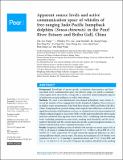Apparent source levels and active communication space of whistles of free-ranging Indo-Pacific humpback dolphins (Sousa chinensis) in the Pearl River Estuary and Beibu Gulf, China
Abstract
Background . Knowledge of species-specific vocalization characteristics and their associated active communication space, the effective range over which a communication signal can be detected by a conspecific, is critical for understanding the impacts of underwater acoustic pollution, as well as other threats. Methods. We used a two-dimensional cross-shaped hydrophone array system to record the whistles of free-ranging Indo-Pacific humpback dolphins (Sousa chinensis) in shallow-water environments of the Pearl River Estuary (PRE) and Beibu Gulf (BG), China. Using hyperbolic position fixing, which exploits time differences of arrival of a signal between pairs of hydrophone receivers, we obtained source location estimates for whistles with good signal-to-noise ratio (SNR ≥ 10 dB) and not polluted by other sounds and back-calculated their apparent source levels (ASL). Combining with the masking levels (including simultaneous noise levels, masking tonal threshold, and the Sousa auditory threshold) and the custom made site-specific sound propagation models, we further estimated their active communication space (ACS). Results. Humpback dolphins produced whistles with average root-mean-square ASL of 138.5 ± 6.8 (mean ± standard deviation) and 137.2 ± 7.0 dB re 1 µPa in PRE (N = 33) and BG (N = 209), respectively. We found statistically significant differences in ASLs among different whistle contour types. The mean and maximum ACS of whistles were estimated to be 14.7 ± 2.6 (median ± quartile deviation) and 17.1 ± 3.5 m in PRE, and 34.2 ± 9.5 and 43.5 ±12.2 m in BG. Using just the auditory threshold as the masking level produced the mean and maximum ACSat of 24.3 ± 4.8 and 35.7 ± 4.6 m for PRE, and 60.7 ± 18.1 and 74.3 ± 25.3 m for BG. The small ACSs were due to the high ambient noise level. Significant differences in ACSs were also observed among different whistle contour types. Discussion. Besides shedding some light for evaluating appropriate noise exposure levels and information for the regulation of underwater acoustic pollution, these baseline data can also be used for aiding the passive acoustic monitoring of dolphin populations, defining the boundaries of separate groups in a more biologically meaningful way during field surveys, and guiding the appropriate approach distance for local dolphin-watching boats and research boat during focal group following.
Citation
Wang , Z-T , Au , W W L , Rendell , L , Wang , K-X , Wu , H-P , Wu , Y-P , Liu , J-C , Duan , G-Q , Cao , H-J & Wang , D 2016 , ' Apparent source levels and active communication space of whistles of free-ranging Indo-Pacific humpback dolphins ( Sousa chinensis ) in the Pearl River Estuary and Beibu Gulf, China ' , PeerJ , vol. 4 , pp. 1-38 . https://doi.org/10.7717/peerj.1695
Publication
PeerJ
Status
Peer reviewed
ISSN
2167-8359Type
Journal article
Description
Grants for this study was provided by the National Natural Science Foundation (NNSF) of China (Grant No.31070347), the Ministry of Science and Technology of China (Grant No. 2011BAG07B05-3), the Knowledge Innovation Program of the Chinese Academy of Sciences (Grant No. KSCX2-EW-Z-4) and the Special Fund for Agro-scientific Research in the Public Interest of the Ministry of Agriculture of China (Grant No. 201203086) to DW, the State Oceanic Administration of China (Grant No. 201105011-3) and NNSF of China (Grant No. 31170501) to KXW and the China Scholarship Council (Grant No. (2014)3026) to ZTW.Collections
Items in the St Andrews Research Repository are protected by copyright, with all rights reserved, unless otherwise indicated.

